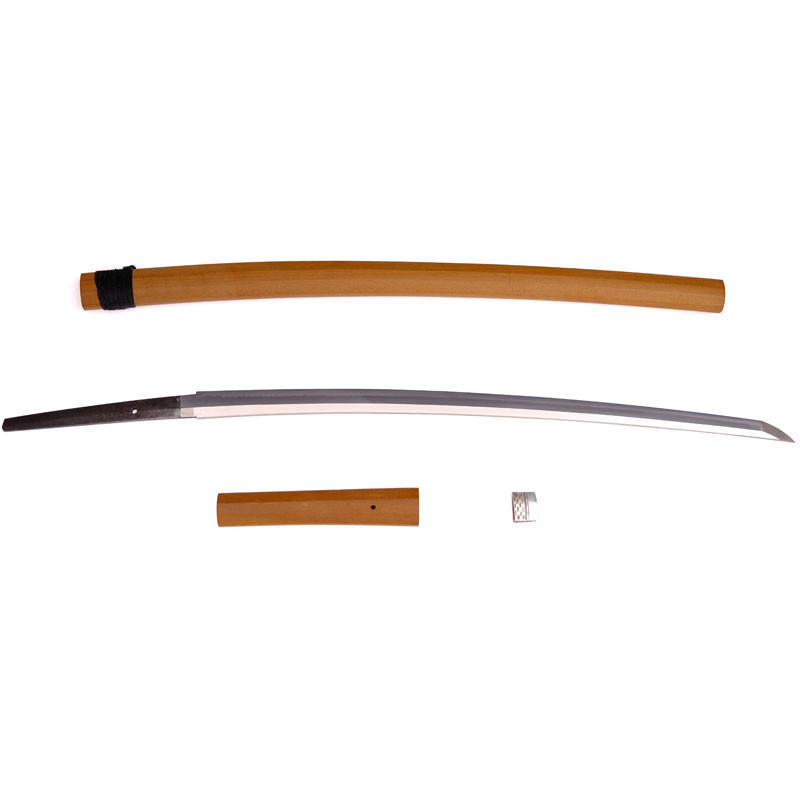












More informations about this product
| Total Weight | 1.565 kg | |
| Weight without Saya | 1.213 kg | |
| Blade Weight | 1.046 kg | |
| Full Blade length (Toshin) | 99.50 cm | |
| Nagasa | 75.50 cm | |
| Nakago Length | 24.00 cm | |
| Sori (curvature) | 1.92 cm | |
| Kissaki Length | 4.48 cm | |
| Moto Haba | 3.61 cm | |
| Saki Haba | 2.38 cm | |
| Moto Kasane | A = 0.73 cm B= 0.82 cm |
|
| Saki Kasane | A = 0.55 cm B = 0.60 cm |
|
| Curvature | Tori Sori (Curvature on the 1st Third) | |
| Type Kissaki | Elongated Chu Kissaki | |
| Blade Structure | Shinogi Zukuri (diamond shaped) | |
| Mune | Iori Mune (triangular) | |
| Hamon | Ko-Gunome Choji Midare and Saka Chojien Nie Deki based on Suguha, with Ashi, Sunagashi and Yo |
|
| Hada | Ko Itame/ Ko Mokume Hada (sumptuous) | |
| Boshi | Ko Maru Kaeri | |
| Nakago | Ubu, Signed Omote 固山宗次作 «Koyama Munetsugu Saku», Dated on Ura side 天保九戌年四月二十三日於千住三ツ胴裁断 «Tenpo 9th year, Year of the dog, 23 April, 3 body cutting test in Senju». 1 Mekugi Ana, Classic Futsu Gata shape, Yasurime Kesho Sujikai, Iriyamagata end (V Dissymmetric). | |
| Saya | Weight 353g, Length 81.30cm, Saya shirasaya in Magnolia | |
| Tsuka & Tosogu (Tsuba, Menuki, Fuchi Kashira) |
- Tsuka: Weight 106g, Length 24.40cm, Tsuka shirasaya in Magnolia -Habaki: Weight 58g, Habaki Silver |
|
| Study & Team Review |
This blade is signed Koyama Munetsugu 固山宗次作, of his civil name "Koyama Soubei", is also known as "Bizen No Suke Munetsugu" 備前助宗次. Born in 1803 and died in 1872, He was originally from the Shirakawa Estate in Mustu Province (Oshu), in the northern part of Honshu (main island of Japan). He was the youngest of three siblings, Koyama Munehira (固山宗平) and Koyama Munetoshi (固山宗俊). He worked at the time as an official blacksmith for the Shirakawa Matsudaira clan. Then moved to Kuwana province, Mie prefecture, near Nagoya. Finally in 1845, he moved to the capital Edo, today Tokyo, and obtained the title of «Bizen No Suke». He studied under Kato Tsunahide 加藤綱英 and was an apprentice to Tsunatoshi Shunsai 長運斎綱俊, Tsunahide’s younger brother. His blades are known for his mastery of Bizen’s quenching lines and the effectiveness of their cutting edge, making him one of the best Shinshinto blacksmiths of the 19th century. In the style of Bizen, Koyama Munetsugu made an utsushi of the blade «Koryu» of Osafune Kagemitsu, originally produced in 1322. The blade presented here is very similar in terms of hardening line, Ko-choji and Ko-gunome Sakachoji's style with a lot of Ashi and Yo. Koyama Munetsugu is such a talented blacksmith that he worked for the Matsudaira clan, from which the Shogun Tokugawa Ieyasu, the last of Japan’s three reunificators, won the Battle of Sekigahara and unified the clans. This blade is absolutely magnificent and of great power, the forging work is very close to Tairyusai Munehiro 泰龍斎宗寛, the best student of Koyama Munetsugu. Munehiro 宗寛 can be read as "Sokan", he is often called by this name. Talented, like his master, Sokan's blades are sometimes classified as Juyo, particularly important and precious achievements. This classification demonstrates a very high mastery of forging. Tairyusai Munehiro was born in 1818 and was from the same domain as Koyama Munetsugu, the Shirakawa domain. He was also the son of a Samurai from the Shirakawa domain. He learned forging with Koyama Munetsugu in the Oshu province. Then, on Munetsugu's recommendations, he lived in the Fukagawa district of Edo (Tokyo), east of the Sumida River. His first known works date from 1847. His style was then very close to his master Koyama Munetsugu, in the style of the Bizen tradition. In 1854, he made his name Tairyusai Sokan official and began to create his own style as we can see on this blade. He died in 1883. What is quite remarkable is that Sokan forged even at a great age, and this despite the ever-increasing restrictions against Samurai and the wearing of swords at the beginning of the Meiji era, from 1868. It must therefore be noted that despite the restrictions, his talent was still respected, appreciated and sought after. Many blades of Munetsugu and Sokan were tested by the Yamada 山田 family, official professional testers, notably by Yamada Yoshitoshi and Yamada Asauemon Yoshimasa. Most of the tests on bodies were done in Senju where Denma-Cho prison, Denma-Cho Royashiki 伝馬町牢屋敷, was located. This prison was located in Tokyo, near the Nihonbashi district. It was known because between 100,000 and 200,000 people were executed there during the Edo period, for about 200 years. Today, the Dai-Anraku temple is built on the execution ground of the time in order to appease the spirits of the condemned. This blade signed Munetsugu is an impressive blade, with incredible steel grain and an exceptional flamboyant temper. |
|
Share your opinion
error Your review appreciation cannot be sent
feedback Report comment
check_circle Report sent
error Your report cannot be sent